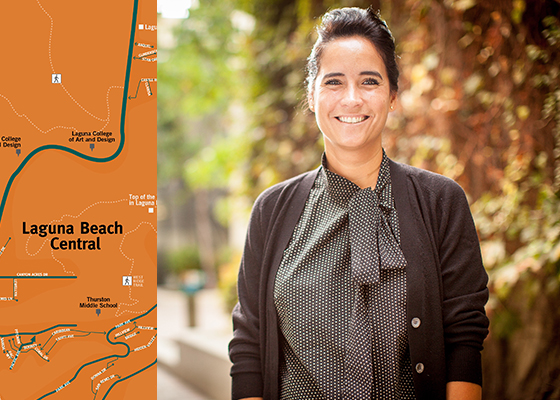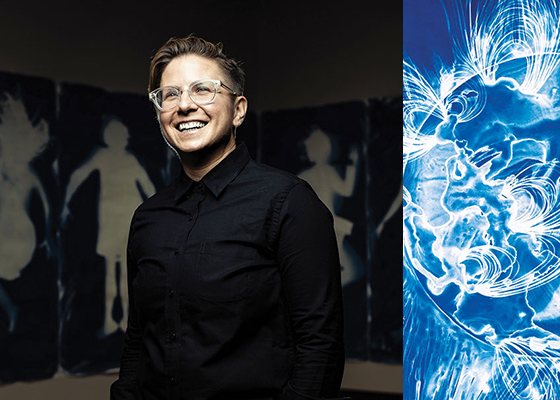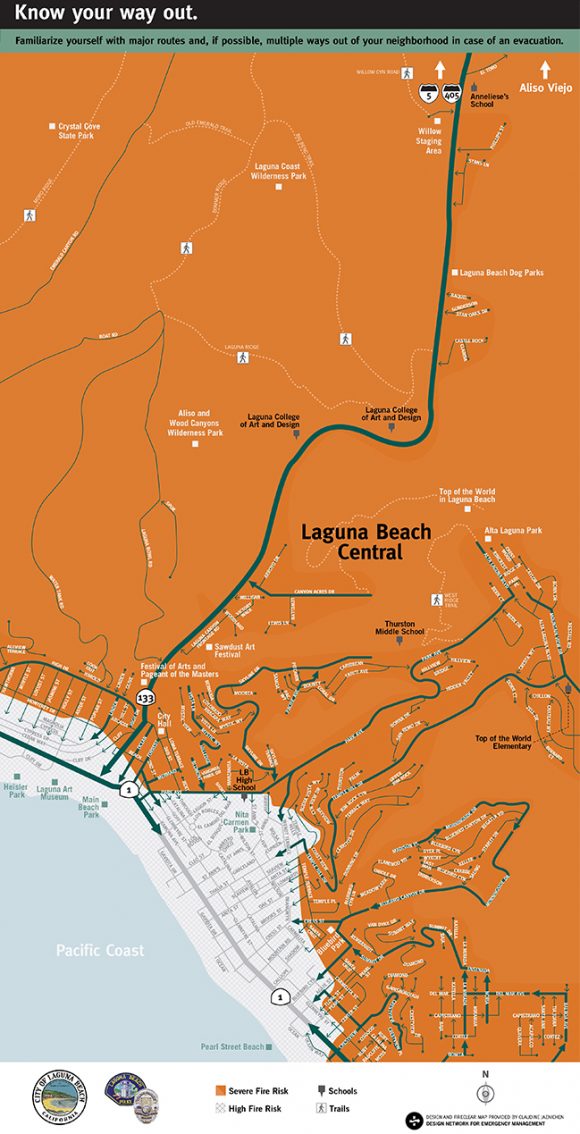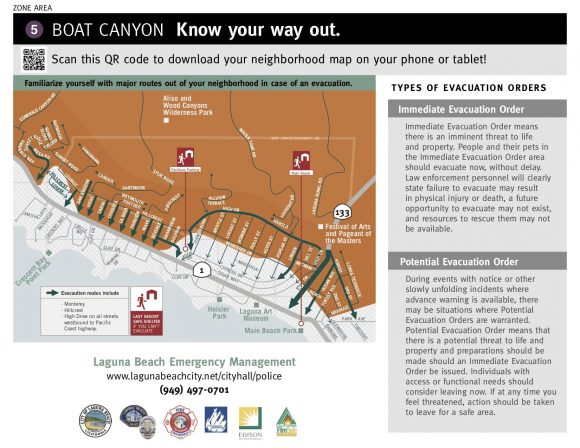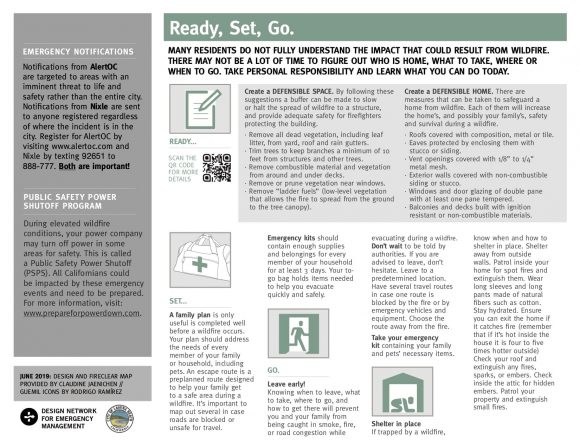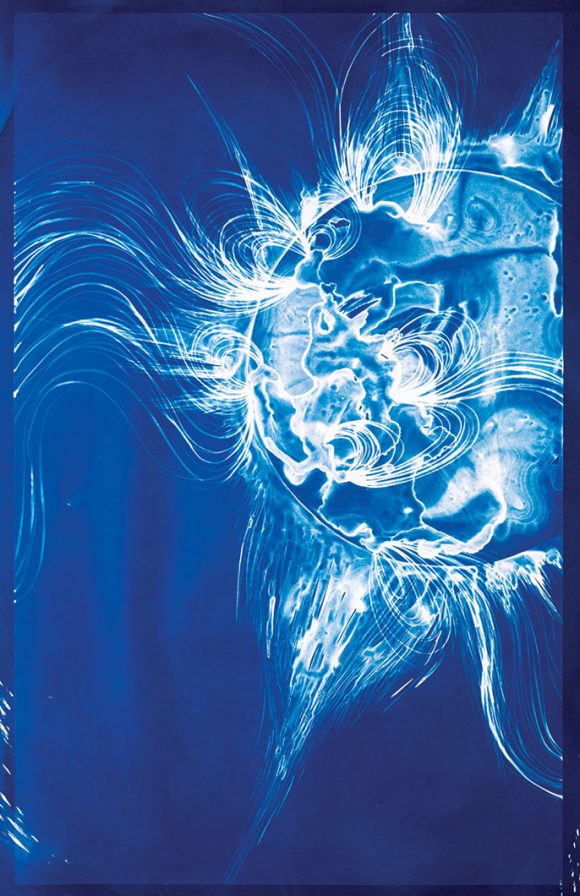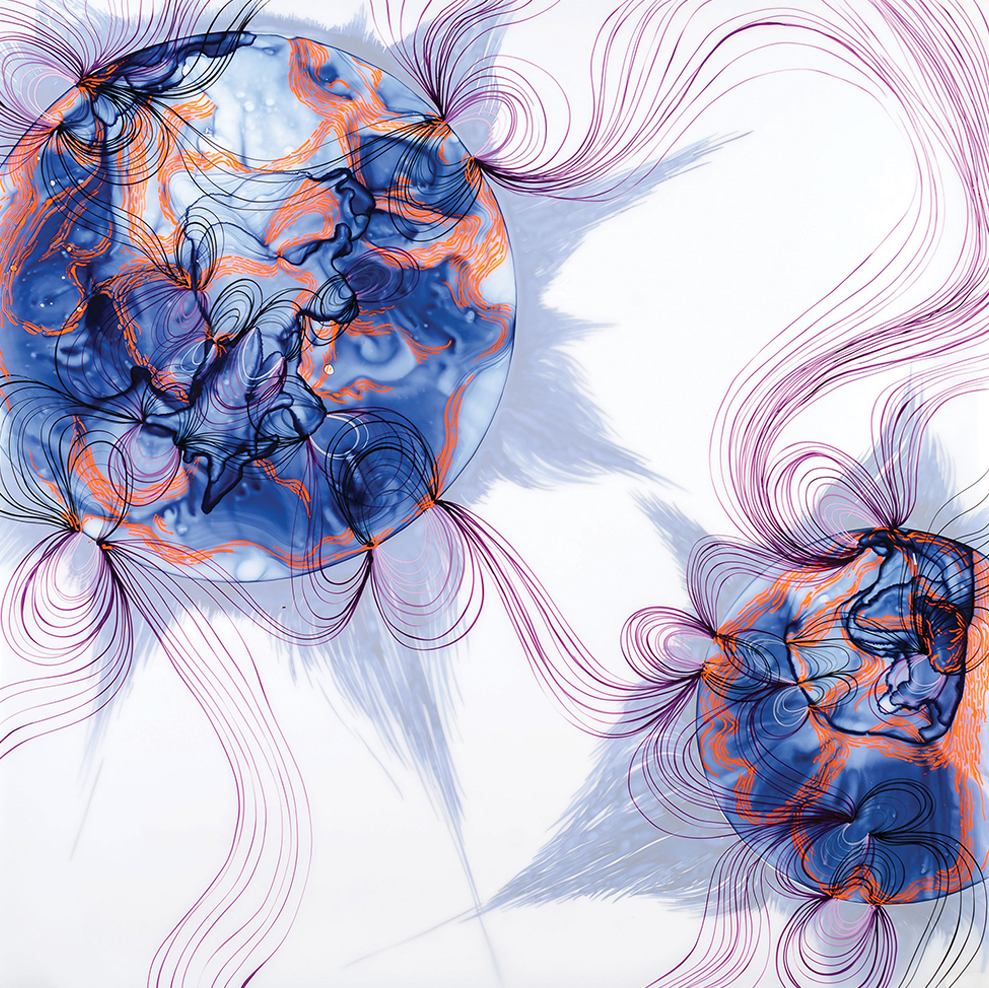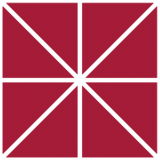
Of Earth And Sky
WITH THEIR CREATIVE APPROACH TO COLLABORATIVE PROJECTS, GRAPHIC DESIGNER CLAUDINE JAENICHEN AND VISUAL ARTIST LIA HALLORAN HELP US FIND OUR WAY IN WORLDS FULL OF CHANGE.
Life is complicated. Thank goodness for humanities scholars, who help us make some sense of it all. Two Chapman University art professors take up that challenge in unique ways, deploying artistic talent and creativity – what some might call “soft skills” – to enlighten their fellow humans.
Graphic artist and information designer Claudine Jaenichen applies artistic insights to disaster evacuation maps that aid a most human drive – survival in the midst of earthly chaos. Meanwhile, studio artist Lia Halloran combines history with imagination to explore mysteries of science and the celestial sky.
At the heart of their work is connection – the links and bridges they build between people and disciplines, helping us navigate our ever-changing world.
IMAGINE YOURSELF
the emergency manager of a city with thousands of residents living in some of the country’s most fire-prone canyons and hills, where neighborhoods border chaparral-covered open spaces and the streets wend and wind like tangled spaghetti.
Now consider preparing those folks for the day a brush fire threatens their safety and requires swift evacuations. An easy-to-read map might come in handy, yes?
That’s the thinking of many California emergency managers, for whom such scenarios are real possibilities in an era when wildfire reaches into suburban communities. Increasingly, officials are turning to a Chapman University professor of graphic design for help with that specialized job.
With a combination of design and research, Claudine Jaenichen creates specialized maps distilled to a central message – know your way out. It’s a branch of design called wayfinding. Emergency managers call it lifesaving.
“Claudine is a hidden treasure in emergency management for a lot of us,” says Jordan Villwock, emergency operations coordinator for the Laguna Beach Police Department, just one of the agencies calling on an expertise that is not so hidden anymore.
Jaenichen is recognized widely for bringing a singular vision to evacuation maps and disaster-preparedness materials. This year alone she gave a FEMA PrepTalk on effective communication in emergencies and presented visual communications recommendations to managers with the Center for Homeland Defense and Security. She also serves on the executive boards for the International Institute of Information Design and the Design Network for Emergency Management.
Much of that attention grew out of a project that harnessed her humanities-based skills with the science of human behavior. In a collaboration with Steve Schandler, Ph.D., director of Chapman’s Cognitive Psychophysiology Lab, she tested and developed tsunami evacuation maps for California coast cities, supported by the California Governor’s Office of Emergency Services and packaged as TsunamiClear. Today those directional signs dot the California coast.
Now Jaenichen is applying valuable lessons from that research to develop evacuation maps for communities living in wildfire zones. She titled it FireClear and deployed similar design sensibilities – thick directional arrows, removal of extraneous details and inclusion of only significant landmarks and preferred escape routes. The project also receives state support.
The guide evokes the iconic London Underground map, with its clean and stylized route depictions. Naturally, the actual tracks twist and turn along their way, but that’s not essential information for riders who just need to see how to get from point A to point B.
“You cannot place (the routes) over Google Maps. They will not match up. They’re more like a diagram,” Jaenichen says.
Obviously, tsunamis and fires are different beasts, with unique challenges. Where tsunami tides are relatively predictable, fire patterns are more capricious.
As emergency managers see it, the fire maps will be more useful before an emergency because they’ve been mailed to homes and help build risk awareness long before the first sparks fly. It’s not that the residents are unaware of their local roads, but they may not realize which ones the city has designated as the best routes leading to safety, she says.
“This is really about building cognition and inviting the public to understand the region’s fire history. We want to let them know the potentially dire situation they can be in if they don't leave when they’re supposed to leave,” Jaenichen says. “Hopefully, they won’t delay.”
Residents in the cities of Laguna Beach and Aliso Viejo already received the maps and informational brochures as part of outreach programs that also include a variety of awareness events. Mobile apps are also in the planning stages.
Everyone in this work carries a grim reminder of the project’s urgent need. The 2018 Camp Fire in California’s Butte County tore through more than 153,000 acres and took 86 lives. In 2017, the inferno that swept through the Sonoma and Napa wine country cost 22 lives.
“It’s so important,” says Villwock, whose city has seen major fires and evacuations, as well as floods and landslides. “A map in a disaster is worth a billion words.”
Jaenichen hopes to receive funding to study the evacuation plans that were in place before and after the major California fires. She also wants to evaluate the messaging and understandability of FireClear. The academic in her itched to have user evidence in hand to fine-tune the maps, which was her process with TsunamiClear. But cities’ needs were urgent, she says.
“Fire makes me so nervous. It’s crazy and organic,” she says. “But this is so relevant, and it’s prioritized nationally because it does the most damage. It occurs every year.”
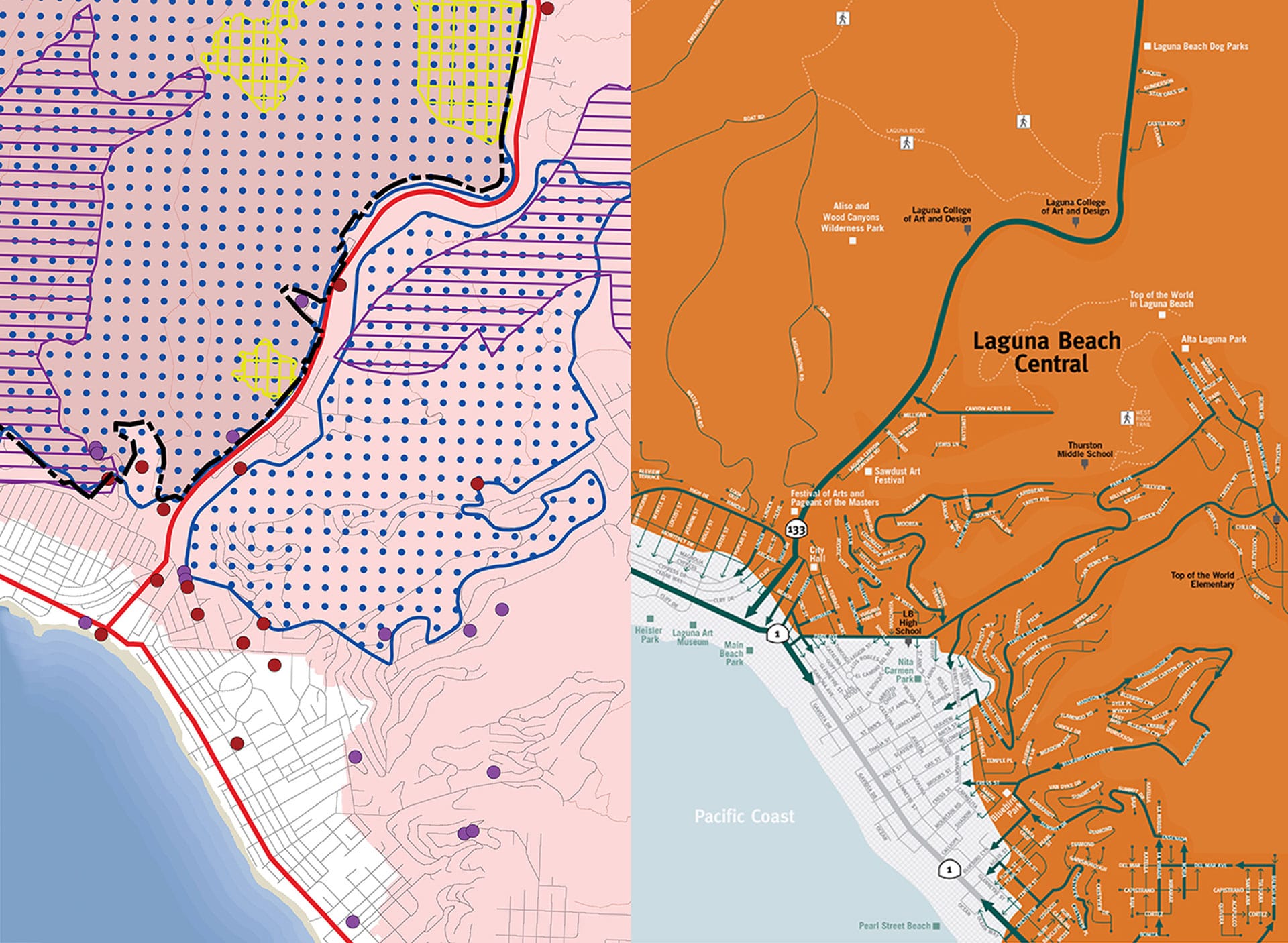
‘I WANT THERE TO BE SOME TRANSLATION AND EVOLUTION.’

LIA HALLORAN USED TO TAKE THE SUN FOR GRANTED.
Then she watched in awe as it revealed its secrets.
In 2017, the visual artist and Chapman University assistant professor of art traveled to rural Oregon to witness a solar eclipse. Even for Halloran, whose work is steeped in the mysteries of science, the experience overwhelmed.
“It’s outside of language,” Halloran says. “The earth goes quiet and this shadow falls across you. You see the corona that was there all the time but you’ve never seen it before. You rethink this thing that’s around us all the time.”
Interpreting such scientific wonders animates Halloran’s creative world.
When her artistic interests tilt toward astrophysics, she partners with Nobel Prize-winning physicist Kip Thorne and her work evokes telescopic views into the heavens. When she starts taking flying lessons, she mounts GoPro cameras all over the plane to record her first solo flight and turn it into “Double Horizon,” an immersive three-channel video installation.
When she draws inspiration from the sun, she enlists a handful of fellow explorers to reinvent a century-old process, creating huge cyanotype prints that pulse with energy and connect to a vein of scientific research too long ignored.
On view through Nov. 22 at the University of Maryland Art Gallery, Halloran’s exhibition “The Same Sky Overarches Us All” exemplifies her collaborative and creative spirit. She uses those large-scale cyanotype prints to bring to light historic work by women astronomers. Halloran pays homage to the 19th-century women “computers” of the Harvard College Observatory with evocative images, some of which depict them in sky-blue silhouettes.
Back in the day, women weren’t allowed at the telescope, but in back rooms they analyzed data that was collected on glass photographic plates. Halloran and her team combed through an archive of these plates, which serve as century-old snapshots of the night sky.
“These women helped lay the foundation of astronomy, and I had never heard of them,” says Halloran, who was aided in her research by Chapman student Kayla Quinlan ’19.
“It’s awesome to see how Lia interprets what’s on those glass plates and turns it into a work of art,” Quinlan says. “It’s not just about imitating what’s there, but understanding it.”
The exhibition unites Halloran’s large-scale cyanotypes with her “Double Horizon” video installation to “examine how perception, time and scale inform the human desire to understand the world and our emotional and psychological place within it,” Halloran says in the gallery description. It’s the artist’s largest museum show to date, highlighting a five-year project made possible in part by a grant from the National Endowment for the Arts.
For Garret Hill ’18, like Quinlan a studio assistant who first joined Halloran’s team while a student at Chapman, the project shows how to realize an outsized artistic vision. In addition to studio work, Hill did the video editing on “Double Horizon.”
As the cyanotype-print process begins, Hill marvels as Halloran transforms Dura-Lar film into cosmic wonders with her brush strokes. Then he helps place the film between sheets of Plexiglas for exposure to the sun and the creation of the prints. Some of the resulting works are so big that it takes serious strategizing just to get them out of the studio.
“We’re always working on the process, always learning, which keeps it exciting,” Hill says. “Lia is an incredible artist. It’s a privilege to help with these works.”
Halloran is never afraid to explore expansive ideas, whether she is collaborating with students, scientists or fellow artists, including Chapman professors Claudine Jaenichen (graphic design) and Anna Leahy (poetry), who are frequent partners on multimedia projects.
“I want my work to inspire curiosity,” Halloran says. “I want there to be some translation and evolution.”
It’s a happy consequence that so many of her projects coax her into the warmth of collaboration and the light of our nearest star. In fact, Halloran’s new piece, for the Simons Foundation and the Flatiron Institute in New York, will depict the sun itself, reflecting research into historic solar drawings done from NASA scans at the Mount Wilson Observatory.
“This work is essentially a solar selfie; we’re making an image of the sun printed by the sun,” Halloran says. “I had never thought of the sun as a subject of artwork. But then the thing that’s closest to you is often the thing you take for granted.”
